Mikael Agricola
This articleneeds additional citations forverification.(November 2018) |
The Right Reverend Mikael Agricola | |
|---|---|
| Bishop of Turku | |
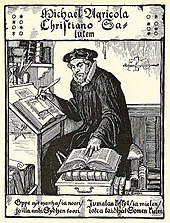 Drawing of Mikael Agricola byAlbert Edelfelt(1854–1900). No contemporary depictions of Agricola have survived. | |
| Church | Church of Sweden |
| Diocese | Turku |
| In office | 1554–1557 |
| Predecessor | Martti Skytte |
| Successor | Petrus Follingius |
| Orders | |
| Ordination | 1531 |
| Consecration | 1554 byBotvid Sunesson |
| Personal details | |
| Born | c. 1510 |
| Died | 9 April 1557(aged 46–47) Uusikirkko,Karelia,Sweden(nowRussia) |
| Nationality | Finnish |
| Denomination | Lutheran |
| Part ofa serieson |
| Lutheranism |
|---|
 |
Mikael Agricola(Finnish:[ˈmikɑelˈɑɡrikolɑ];c. 1510 – 9 April 1557) was aFinnishLutheranclergyman who became the de facto founder of literaryFinnishand a prominent proponent of the ProtestantReformationinSweden,includingFinland,which was a Swedish territory at the time. He is often called the "father of literary Finnish".
Agricola was consecrated as thebishop of Turku(Åbo) in 1554, without papal approval. He continued thereformof theFinnish church (then a part of the Church of Sweden)alongLutheranlines. He translated the New Testament into Finnish and also produced the prayer book and hymns used in Finland's new Lutheran Church. This work set the rules of orthography that are the basis of modern Finnish spelling. His thorough work is particularly remarkable in that he accomplished it in only three years.
He died of sudden illness while returning from a trip during which he assisted in negotiating theTreaty of Novgorodwith theTsardom of Russia.
Biography
[edit]Early life
[edit]Michael Olaui or Mikael Olofsson (FinnishMikael Olavinpoika) was born in c. 1510 in the village of Torsby inPernå(Pernaja),Nyland(Uusimaa), in what now is part ofFinlandbut then was part ofSweden.He was named after the patron saint of Pernå's church. The exact date of his birth, like most details of his life, is unknown. His family was a quite wealthy gentry family according to the localbailiff's accounting. He had three sisters, but their names are not known. His teachers apparently recognized his aptitude for languages and his rector Bartholomeus sent him toViborg(Fi.Viipuri;now Vyborg,Russia) forLatin schooland somepriestlytraining, where he attended the school of Erasmus. It is not known whether his first language was Finnish or Swedish; Pernå was mostly a Swedish-speaking district, but the language he used in his works indicates that he was a native speaker of Finnish.[1]However, he mastered both languages like a native speaker and was possibly a bilingual child.[2]
Studies
[edit]When Michael studied inViborg(Viipuri) he assumed the surname Agricola ( "farmer" gv. "agriculture" ); surnames based on one's father's status and occupation were common for first-generation scholars at the time. It was probably in Viipuri where he first came in touch with theReformationandHumanism.The Viipuri castle was ruled by a German count,Johann,who had served the king of Sweden,Gustav Vasa.The count was a supporter of the Reformation, and they already heldLutheranservices.[2]
In 1528 Agricola followed his teacher toTurku(Åbo), then the center of the Finnish side of theSwedishrealm and the capital of thebishopric.There Agricola became a scribe in bishopMartinus Skytte's office.[2]While in Turku Agricola metMartin Luther's first Finnish studentPetrus Särkilahti,who eagerly spread the idea of the Reformation. Särkilahti died in 1529, and it was up to Agricola to continue Särkilahti's work. Agricola was ordained for priesthood sometime in the early 1530s.[3]
In 1536 the bishop of Turku sent Agricola to study inWittenbergin Germany. He concentrated on the lectures ofPhilipp Melanchthon,who was an expert inGreek,the original language of theNew Testament.In Wittenberg Agricola studied under Luther.[4]Agricola got recommendations to Swedish KingGustav Vasafrom both of the reformers.[3]He sent two letters to Gustav, asking for a confirmation for astipend.When the confirmation came, Agricola bought books (for example, the complete works ofAristotle). In 1537 he started translating the New Testament into Finnish.[citation needed]
Rector and ordinarius
[edit]In 1539 Agricola returned to Turku and ended up as the rector of Turku (Cathedral) School. He did not like his job, calling his students "untamed animals". At the time Gustav Vasa had confiscated the property of the church when he was consolidating his power but he also drove the Reformation. In 1544 Agricola received an order from the crown to send several talented young men toStockholm's ta xing offices. For some reason, Agricola did not obey until the order was sent again the next year, with a more menacing tone. This episode probably affected their relations negatively.[3]
In 1546 Agricola lost his home and school in the Fire of Turku. On 22 February 1548, Gustav Vasa ordered Agricola to retire from his position as a rector. At this time Agricola was already married, but history knows his wife only by her name: Pirjo Olavintytär (Bridget, "daughter of Olavi"; Birgitta Olafsdotter, Brigida Olaui). His only son,Christian Agricola(Christianus Michaelis Agricola), was born 11 December 1550, and became the bishop ofTallinnin 1584.[citation needed]
When an old bishop died in 1554, Gustav Vasa had Agricola consecrated as theordinariusof Turku parish – for all practical purposesBishopof Turku and by extension the first Lutheran bishop for all Finland. Agricola was not a particularly strict or dedicated reformer, although he did remove theCanon of the Mass.[citation needed]
Death
[edit]In 1557, Agricola headed a delegation going toRussiaon a diplomatic mission, and was inMoscowfrom 21 February to 24 March negotiating apeace treaty,theTreaty of Novgorod (1557).On 9 April he fell ill and died on Kyrönniemi peninsula near theUusikirkko(now Polyane) village on theKarelian Isthmus.[5]This day is alsoElias Lönnrot's birthday and it is celebrated in Finland as the day of the Finnish language.[3]Agricola was probably buried inside Viipuri's church, but the exact location of the grave is not known.[6]
Literary achievements
[edit]Abckiria
[edit]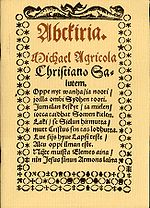
Agricola had thought about translating theNew Testamentin his early years of study. At the time, however, there was no standard written form ofFinnish,so he started developing it. His first book,Abckiria,which is nowadays known as the "ABC-kirja" or ABC book, was aprimerfor reading and acatechism.It was first printed in 1543.[7]The catechism was included because only very few people could afford the wholeBibleat the time. The first printing contained 16 pages.
A second printing was released in 1551[3]with 24 pages.
In 1966 Åke Åbergin, a librarian, discovered parts, while repairing book bindings, from an as yet unknown (likely the third) edition of the "ABC-kirja" that included the name of the printer, Amund Lauritsanpoika, and fortuitously the publishing date of 1559 (two years after the author's death) of the final as yet undiscovered 8 pages. The pages were likely the result of an imposing error and relegated to padding paper.[8]
Rucouskiria
[edit]Agricola'sRucouskiria Bibliasta(contemporary Finnish spelling: Rukouskirja; literally, "Prayer Book from the Bible" ) was printed in March 1544. At the beginning of the book, Agricola wrote about many topics concerning all-roundeducationand the Reformation's effects in Finland.[7]The book includes four prefaces and about 700 prayers on many topics;[3]it even has twelve structurally different kinds of prayers, instead of the usual two or three. It is the most independent work by Agricola and contains approximately 900 pages. His sources include the works ofLuther,Melanchthon,andErasmus.[citation needed]
New Testament translation
[edit]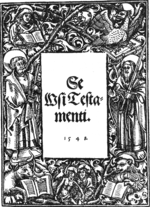
Agricola's most prominent book is the firstFinnish-language translationof theNew Testament.The manuscript was completed in 1548. It contains 718 pages and many illustrations.[7]
Liturgical books
[edit]While Agricola was in Wittenberg, he translated three smallerliturgical booksinto Finnish. These books were printed in 1549.[7]
Käsikirja Castesta ia muista Christikunnan Menoistaincludes forms for christening, marriage and burial, as well as speeches for the sick, mourning and dying. It is translated fromOlaus Petri's corresponding work except for the christening and marriage portions, which are from Luther. It also contains minor elements translated from works ofCaspar Huberinus.
Messu eli Herran echtolinenincludes the form for a service. It is also based on Olaus Petri's work and a few Finnish manuscripts. In this book Agricola revealed his next mission: the translation of theOld Testament.[3]
Se meiden Herran Jesusen Christusen Pina, ylesnousemus ia tauiaisen Astumus, niste Neliest Euangelisterist coghottuontells aboutJesus Christ's suffering. It is collected from all fourgospels.This book was influenced heavily byJohannes Bugenhagen,[7]a teacher inWittenberg.It was mainly translated from the German version, but some parts are influenced by the Swedish version and Agricola's own translation of the New Testament.[citation needed]
Commemorations
[edit]
TheEvangelical Lutheran Church in Americaremembers Bishop Agricola annually on 10 April.[citation needed]
Mikael Agricola Churchin Helsinki is named after Agricola.[9]As well theAgricola Lutheran Churchmemorializes his namesake in Toronto Canada. An asteroid3212 Agricolais named after Agricola.
In 2007, 450 years after his death, Agricola was selected as the main motif for a commemorative coin, the €10Mikael Agricola and Finnish language commemorative coin.This collector coin was issued to honor Agricola's life work as a contributor to the Protestant reformation in Finland and as the father of the Finnish written language. The reverse side depicts a quill to reference the writer, while the coin's obverse side contains an artistic interpretation of a human figure.[10]
Gallery
[edit]-
The original statue of Mikael Agricola inVyborgbyEmil Wikström,photographed on the day of its reveal in 21 June 1908
[note 1] -
1910 recast in theTurku Cathedral
-
1953 recast inLahti
-
Monument near the place of Agricola's death, close toPrimorsk
-
Plaque to Agricola inWittenberg
-
Mikael Agricola Churchin Helsinki named after him
-
Statue of Agricola byCarl Eneas Sjöstrand,1877
-
Statue of Agricola byVille Vallgrenin theHelsinki Cathedral,1887
-
Mikael Agricola Hands Over the Finnish Translation of theNew Testamentto KingGustav Wasa,Robert Wilhelm Ekman,1853
-
Educational poster of Agricola handingSe Wsi Testamenti,the Finnish translation of the New Testament, to Gustav Vasa byAlbert Gebhard
-
The Death of AgricolabyJoseph Alanen,1917
See also
[edit]Notes
[edit]- ^The statue was lost in theWinter War.[11]
- ^The statue was 1993–2009 insideVyborg Library
References
[edit]- ^Tarkiainen, Kari (2010).Ruotsin itämaa.Helsinki: Svenska litteratursällskapet i Finland. pp. 236–243.ISBN978-951-583-212-2.
- ^abcHeininen, Simo (2014)."Agricola, Mikael (1510–1557)".The National Biography of Finland.Retrieved30 April2016.
- ^abcdefgHeininen, Simo (12 April 2021)."Agricola, Mikael".Kansallisbiografia-verkkojulkaisu. Studia Biographica 4.(in Finnish). Helsinki: Suomalaisen Kirjallisuuden Seura.ISSN1799-4349.Retrieved23 August2021.
- ^Lutheran Cyclopediaentry on Agricola, Michael.
- ^Heininen, Simo; Heikkilä, Markku (2002).Kirchengeschichte Finnlands(in German). Vandenhoeck & Ruprecht. p. 70.ISBN3-525-55444-3.
- ^Kauppila, Suvi (28 February 2012)."Arkeologit etsivät Mikael Agricolan hautaa Viipurissa"(in Finnish). University of Turku. Archived fromthe originalon 8 December 2015.
- ^abcde"Kirjallinen työ".Finnish Bible Society(in Finnish). 2007. Archived fromthe originalon 12 May 2016.Retrieved30 April2016.
- ^Penttilä, presented by Aarni (1998).Näköispainos Mikael Agricolan ABCkirian eri painosten sälyneistä katkelmista(reproduction ed.). [Helsinki]: Suomalaisen Kirjallisuuden Seura. p. 32.ISBN951-717-303-2.
- ^"Mikael Agricola Church".Archived fromthe originalon 11 March 2016.Retrieved30 April2016.
- ^:: Mikael Agricolan juhlarahaKolikot
- ^"Muistomerkkihanke 2009"(in Finnish). Mikael Agricola – seura.Retrieved23 August2021.
External links
[edit] Media related toMikael Agricolaat Wikimedia Commons
Media related toMikael Agricolaat Wikimedia Commons- Spreading the Written Word: Mikael Agricola and the Birth of Literary Finnishby Kaisa Häkkinen
- Agricola, Suomen kirjakielen isä(in Finnish)Finnish Bible Society
- Mikael Agricola Society(in Finnish)

![The original statue of Mikael Agricola in Vyborg by Emil Wikström, photographed on the day of its reveal in 21 June 1908 [note 1]](https://upload.wikimedia.org/wikipedia/commons/thumb/4/4f/M._L._Carstens_-_Photograph_of_the_original_statue_of_Mikael_Agricola_in_Vyborg_by_Emil_Wikstr%C3%B6m_.jpg/275px-M._L._Carstens_-_Photograph_of_the_original_statue_of_Mikael_Agricola_in_Vyborg_by_Emil_Wikstr%C3%B6m_.jpg)

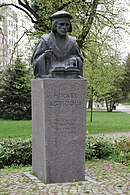
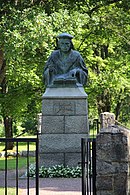
![New 1993 recast in Vyborg [note 2]](https://upload.wikimedia.org/wikipedia/commons/thumb/6/6a/Vyborg_June2012_Teatralnaya_Square_Agricola_Monument.jpg/137px-Vyborg_June2012_Teatralnaya_Square_Agricola_Monument.jpg)
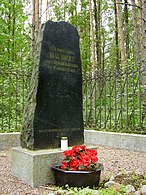
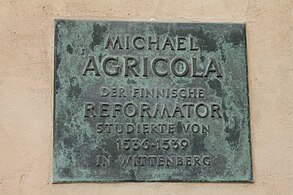




![Educational poster of Agricola handing Se Wsi Testamenti, the Finnish translation of the New Testament, to Gustav Vasa by Albert Gebhard [fi]](https://upload.wikimedia.org/wikipedia/commons/thumb/e/e2/Albert_Gebhard_-_Gustav_Vasa_and_Mikael_Agricola.jpg/267px-Albert_Gebhard_-_Gustav_Vasa_and_Mikael_Agricola.jpg)
![The Death of Agricola by Joseph Alanen [fi], 1917](https://upload.wikimedia.org/wikipedia/commons/thumb/2/2a/Joseph_Alanen_-_The_Death_of_Agricola.jpg/238px-Joseph_Alanen_-_The_Death_of_Agricola.jpg)
